



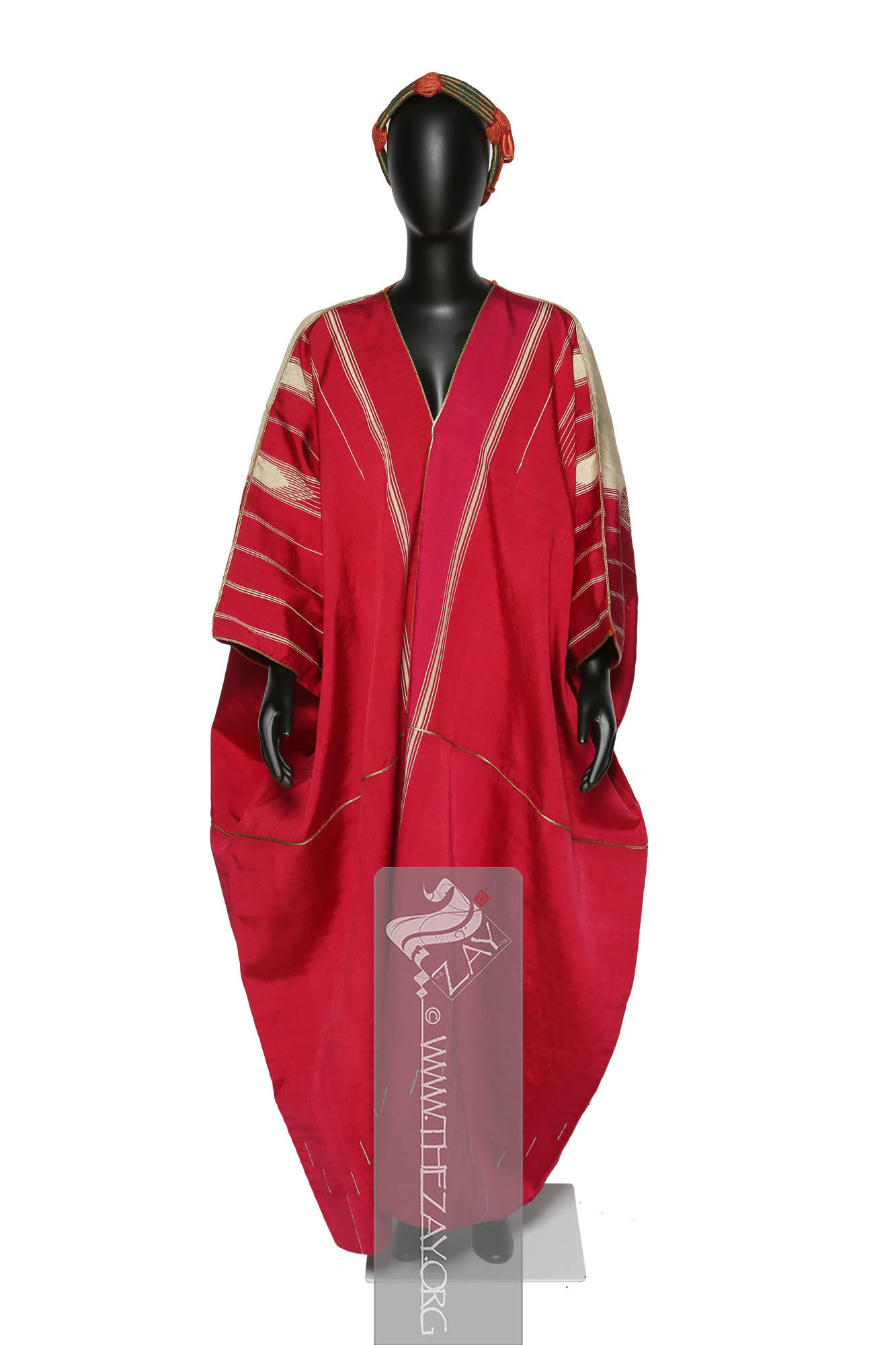
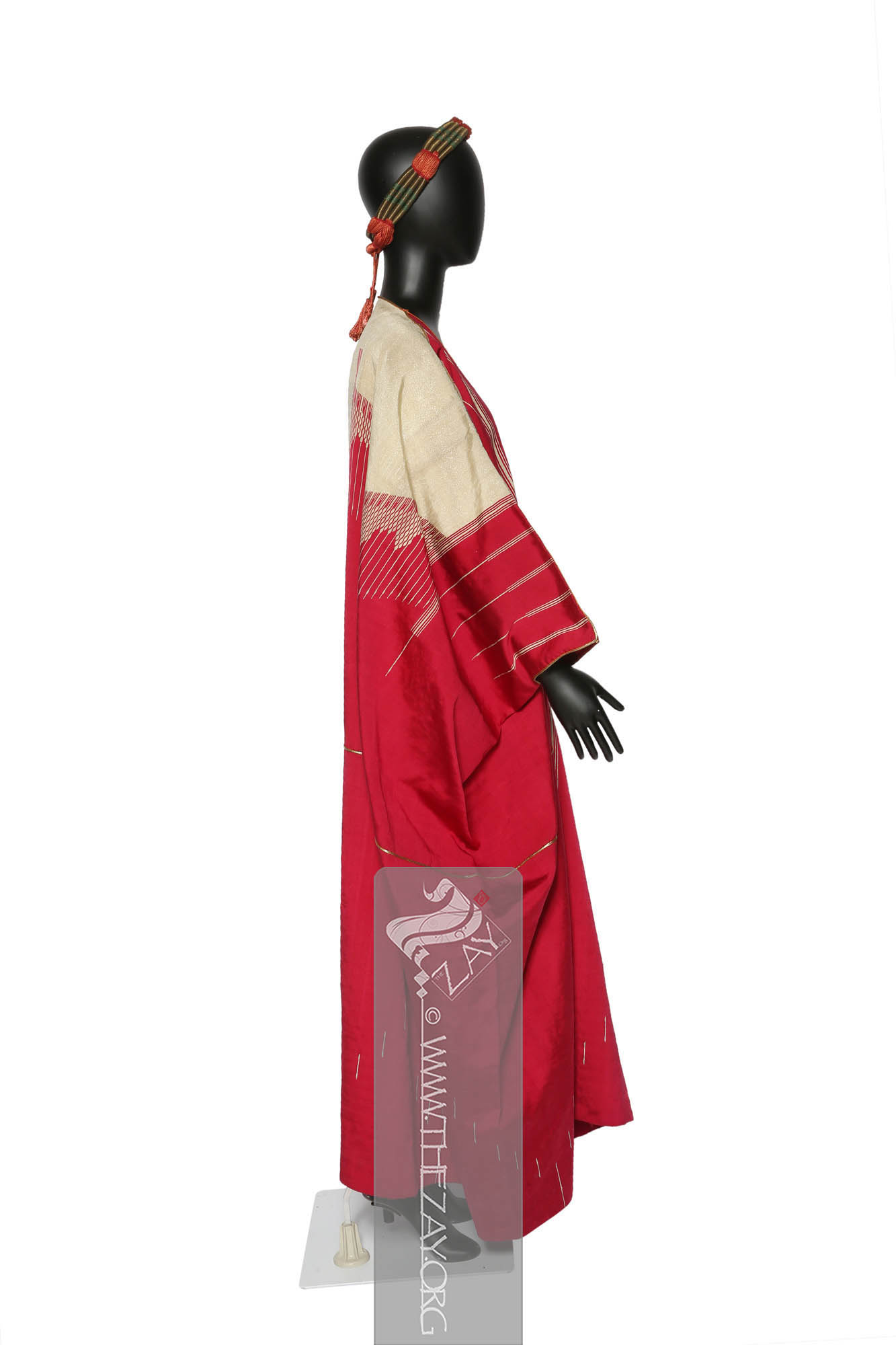

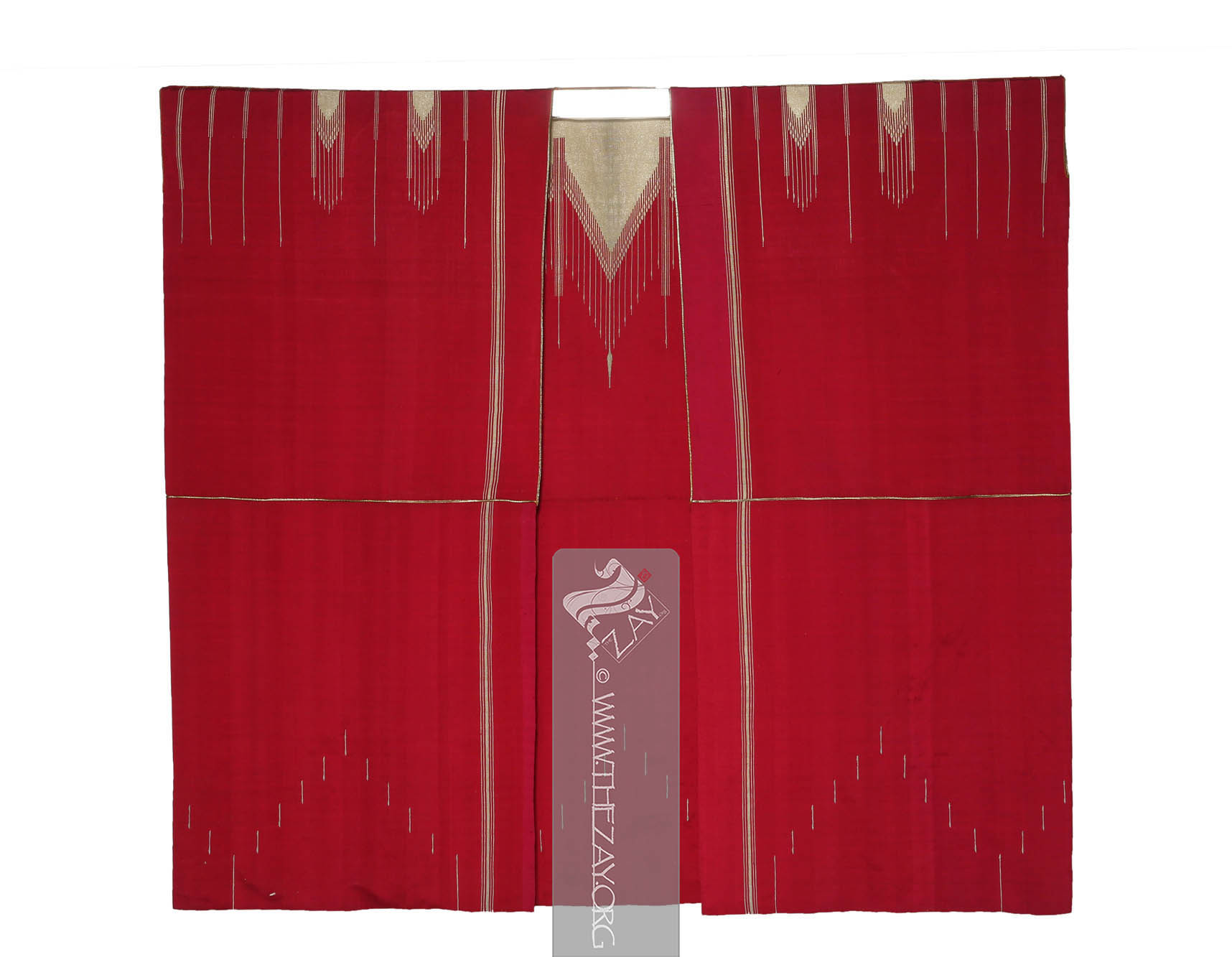
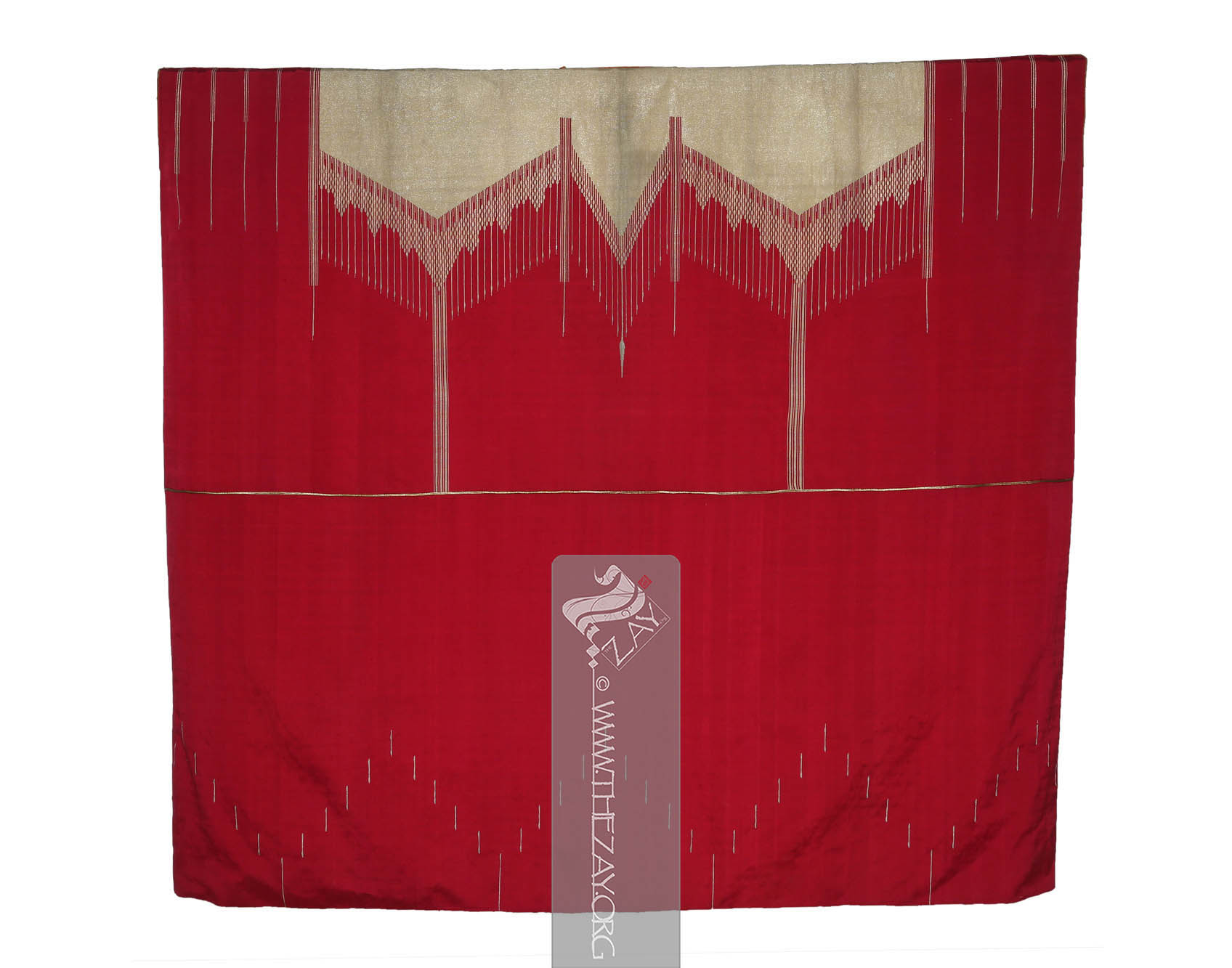
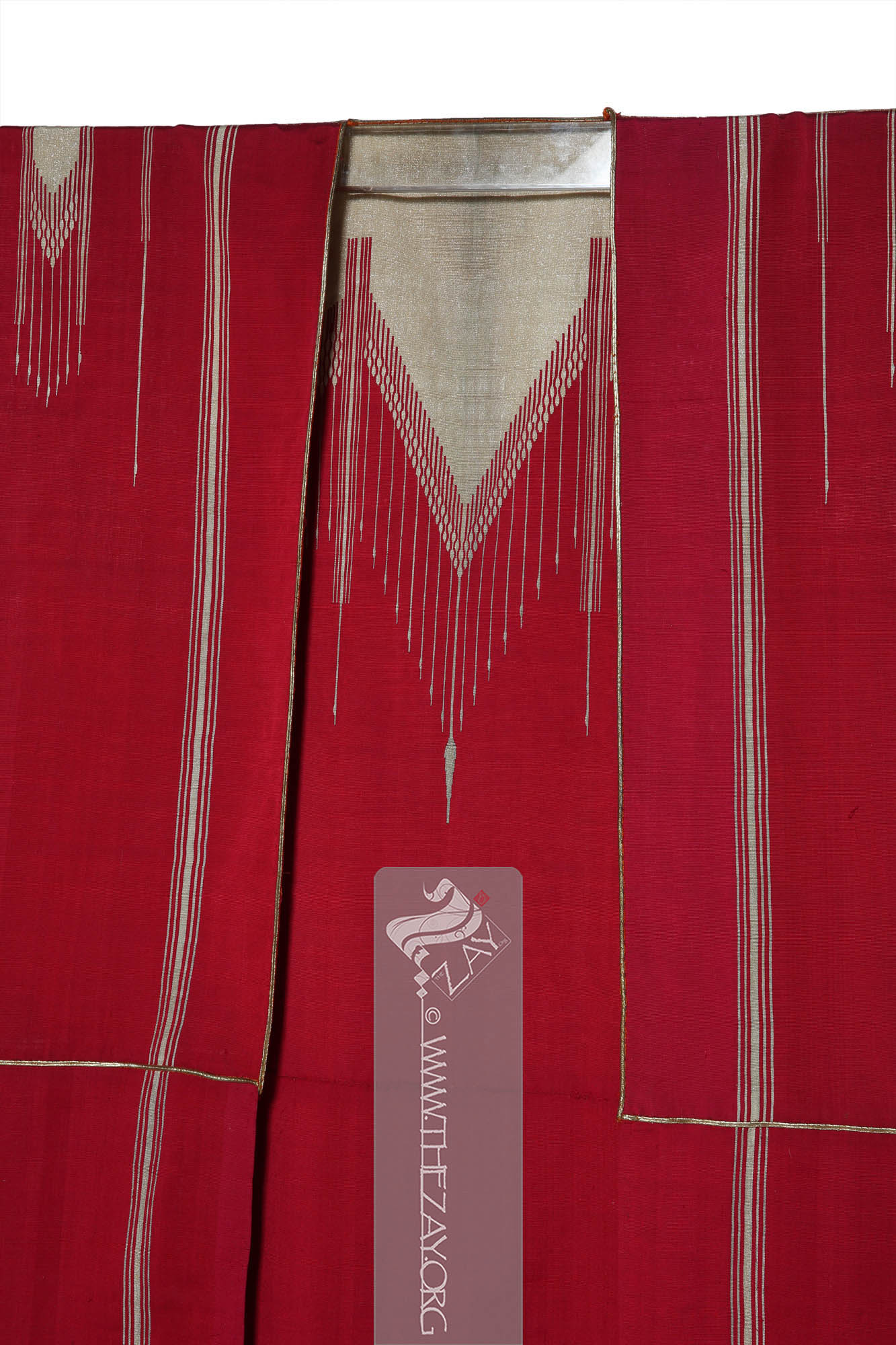
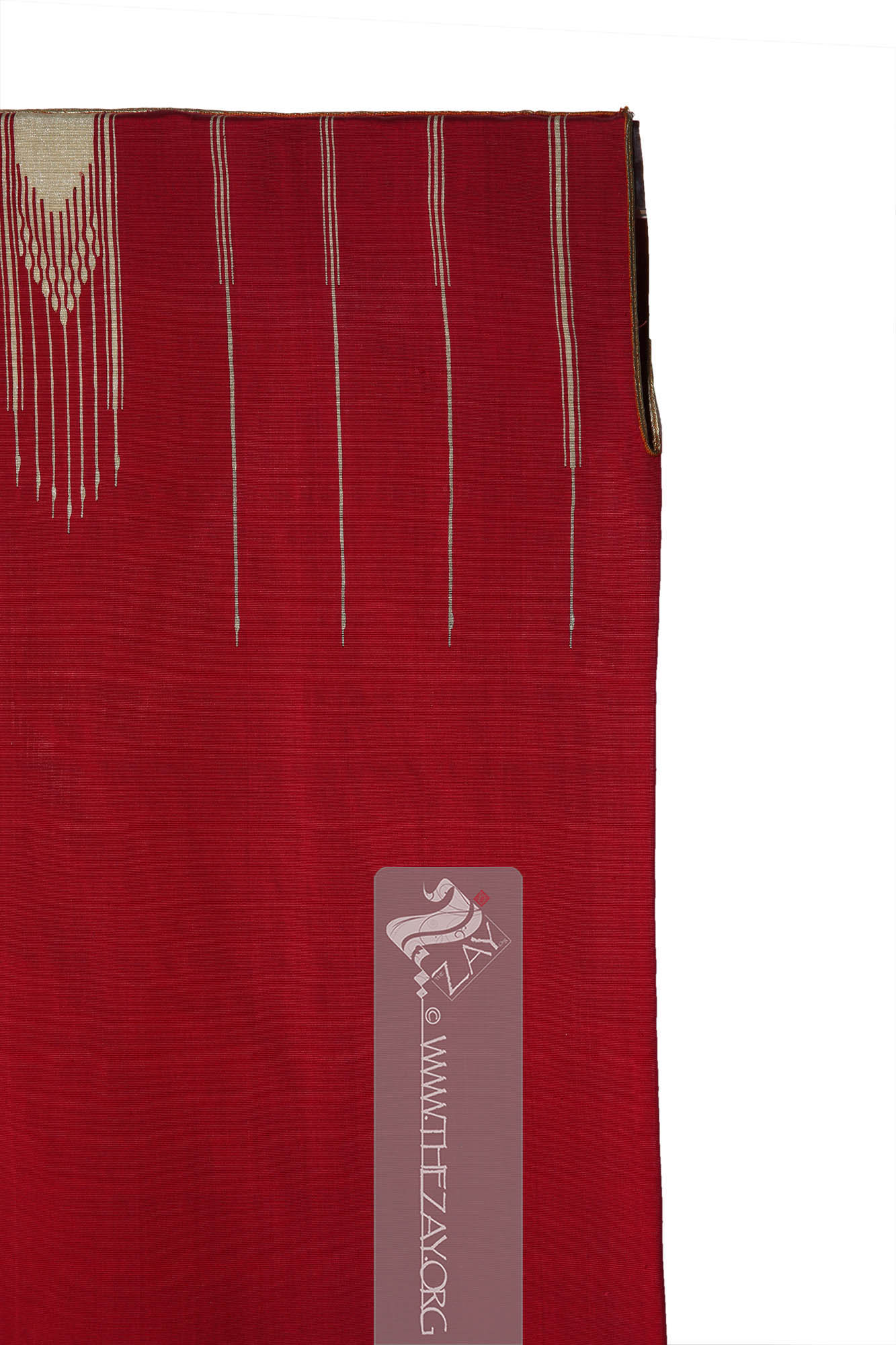
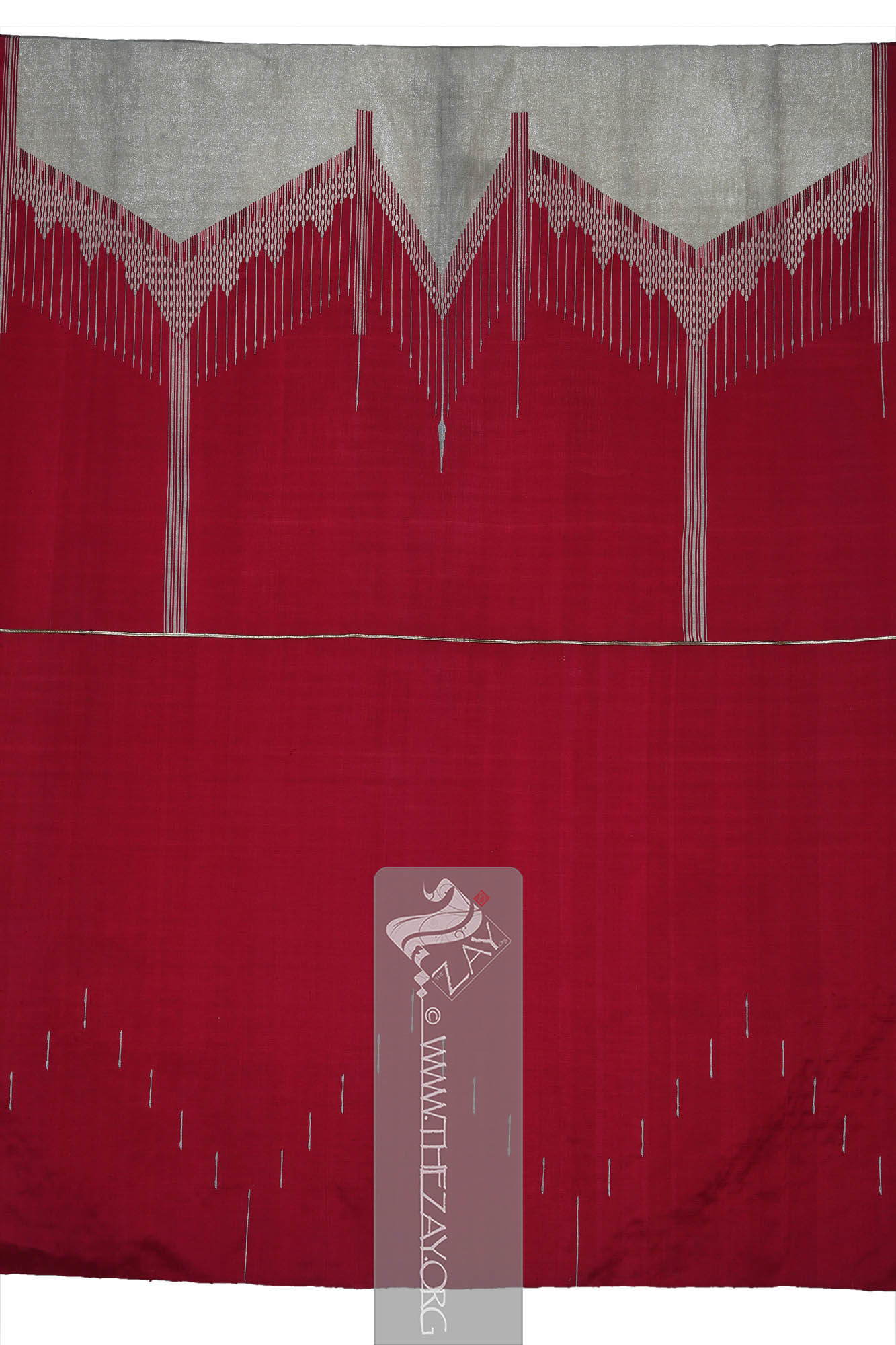

| Local Name | ‘Abayah |
| Object Category | Overgarment |
| Gender | Unisex |
| Date of object | c. 1900 |
| Place Of orgin | Libya |
| Region | - |
| Object Range | Syria, Jordan, Lebanon, Egypt, Palestine, Iraq, Saudi Arabia, Bahrain, UAE, Kuwait, Yemen et al. |
| Dimensions | Length: 135 cm Width: 142 cm |
| Materials | Silk Metal |
| Technique | Hand Stitched Woven |
| Color | |
| Motif | Geometric |
| Provenance | Purchased, Dealer, 2019 |
| Location | The Zay Zay: (Arabic: costume, Pl. azyaā’), a set of clothes in a style typical of a particular country or historical period. Initiative |
| Status | In storage |
| ZI number | ZI2019.500490 SYRIA |
Object Note
Part of an ensemble with another piece (ZI2019.500490 a SYRIA) also in the collection.
Object History
In 2019, Dr. Reem Tariq
Ṭariq: (Arabic; Synonym: tulle_bi_talli
Tūlle_bi_tallī: (French: Tulle – a city in France where fine material for veil was first made; Turkish: tel – wire; Synonym: tariq; talli; badla; khus_dozi ), series of small metal knots made on a woven net ground as embellishment. The term is commonly used in the North African Arab region specifically in Egypt. Ṭariq: (Arabic; Synonym: tulle_bi_talli
Tūlle_bi_tallī: (French: Tulle – a city in France where fine material for veil was first made; Turkish: tel – wire; Synonym: tariq; talli; badla; khus_dozi ), series of small metal knots made on a woven net ground as embellishment. The term is commonly used in the North African Arab region specifically in Egypt.
This gesture was an expression of gratitude for preventing the emir's son from taking his own life, and it is believed that the emir in question might have been Idris Al Senussi.
In the Arab world, this is called an act of khil’ah Khil’ah: (Arabic: khala’a: to take off, or robe of honour; Synonym: Khalat), traditional honorary clothing bestowed by a ruler to an inferior, started by the prophet Mohammed when he removed his cloak and placed it on Ka'b ibn Zuhayr as a mark of honour. A complete khil’ah may include arms, a horse, or an elephant. , from the verb khala’a meaning ‘to take off’, a traditional Islamic honorific gesture, practiced by the prophet, then emulated by others, equivalent to pinning a badge of honour in the West, when a person of high stature takes off his cloak and bestowed it upon another to honour.
Following the passing of the French doctor, the ensemble was sold by his son at an auction to The Zay Zay: (Arabic: costume, Pl. azyaā’), a set of clothes in a style typical of a particular country or historical period. Initiative.
Object Features
This is a front open men’s cloak (‘abayah ‘Abāyah: (Arabic: cloak, Pl. ‘abāyāt, or ‘Ibī. In Classical Arabic: ‘abā’ah, pl: ‘abā’āt, synonyms: ‘Abā, ‘abāh, ‘abāt, dafah Daffah : (Arabic: side, synonyms: ‘Abā, ‘abāyah, ‘abāh, ‘abāt, bisht or mishlaḥ), long, wide, and sleeveless outer cloak worn in public by both sexes. In time this article of dress evolved and changed in shape, style, and function., bisht Bisht: (Arabic: bjd or bjād: cloak, Akkadian: bishtu or Persian: back, pl. bshūt synonyms: ‘Abā,‘abāyah, ‘abāh, ‘abāt, dafah Daffah : (Arabic: side, synonyms: ‘Abā, ‘abāyah, ‘abāh, ‘abāt, bisht or mishlaḥ), long, wide, and sleeveless outer cloak worn in public by both sexes. In time this article of dress evolved and changed in shape, style, and function., or mishlaḥ), long, wide, and sleeveless outer cloak worn in public by men. In time this article of dress evolved and changed in shape, style, and function., or mishlaḥ), long, wide, and sleeveless outer cloak worn in public by both sexes. In time this article of dress evolved and changed in shape, style, and function.) constructed of a bright red ribbed silk and metal thread, possibly gold woven brocade Brocade: (Italian: brocco – twisted thread), is a richly decorative fabric woven with an intricate raised pattern. Its origins can be traced back to ancient China, where it was made for the imperial court. It later spread to Europe during the Renaissance and became popular in couture and decorative arts. fabrics.
The ‘abayah ‘Abāyah: (Arabic: cloak, Pl. ‘abāyāt, or ‘Ibī. In Classical Arabic: ‘abā’ah, pl: ‘abā’āt, synonyms: ‘Abā, ‘abāh, ‘abāt, dafah Daffah : (Arabic: side, synonyms: ‘Abā, ‘abāyah, ‘abāh, ‘abāt, bisht or mishlaḥ), long, wide, and sleeveless outer cloak worn in public by both sexes. In time this article of dress evolved and changed in shape, style, and function., bisht Bisht: (Arabic: bjd or bjād: cloak, Akkadian: bishtu or Persian: back, pl. bshūt synonyms: ‘Abā,‘abāyah, ‘abāh, ‘abāt, dafah Daffah : (Arabic: side, synonyms: ‘Abā, ‘abāyah, ‘abāh, ‘abāt, bisht or mishlaḥ), long, wide, and sleeveless outer cloak worn in public by both sexes. In time this article of dress evolved and changed in shape, style, and function., or mishlaḥ), long, wide, and sleeveless outer cloak worn in public by men. In time this article of dress evolved and changed in shape, style, and function., or mishlaḥ), long, wide, and sleeveless outer cloak worn in public by both sexes. In time this article of dress evolved and changed in shape, style, and function. is essentially constructed of two uncut panels of similar-looking fabrics, stitched to each other horizontally along the (weft Weft: one of the two basic components used in weaving that transforms thread or yarns into a piece of fabric. It is the crosswise thread on a loom that is passed over and under the warp threads.). Following this, the two (warp Warp: One of the two basic components used in weaving which transforms thread or yarns to a piece of fabric. The warp is the set of yarns stretched longitudinally in place on a loom before the weft Weft: one of the two basic components used in weaving that transforms thread or yarns into a piece of fabric. It is the crosswise thread on a loom that is passed over and under the warp threads. is introduced during the weaving process. ) ends are then folded and brought to the middle, and they are stitched on the top along the (selvedge Selvedge: (English: Self-finished edge or self-edge: a dialect forming transition), an edge produced on woven fabric during manufacture that prevents it from unravelling. Traditionally the term selvage applied to only loom woven fabric, presently it could be applied to flat knitted fabric too. ), thus giving it the structure of a square-shaped front open garment.
A sliver is then cut through the top corners of the vertically folded sides to create the armholes. While the top fabric of the garment has geometric patterns of thin, straight, and wavy lines running parallel to one another emerging from triangular gold panels of different dimensions imitating (ikat Ikat: (Indonesian and Malay: Chord, thread, bundle; Synonym: atlas, adras), is a resist dyeing technique that involves tying and dyeing yarns or threads before weaving, resulting in a distinct pattern. With strong traditions in Southeast Asia, Central Asia, the Indian subcontinent and Central America it probably originated independently around the world. ) patterns, the lower half of the garment has thin straight lines.
A braided metal trimming of possibly gold thread is used to embellish the seamlines and the hem along the armholes and the top half of the front opening. The ‘abayah ‘Abāyah: (Arabic: cloak, Pl. ‘abāyāt, or ‘Ibī. In Classical Arabic: ‘abā’ah, pl: ‘abā’āt, synonyms: ‘Abā, ‘abāh, ‘abāt, dafah Daffah : (Arabic: side, synonyms: ‘Abā, ‘abāyah, ‘abāh, ‘abāt, bisht or mishlaḥ), long, wide, and sleeveless outer cloak worn in public by both sexes. In time this article of dress evolved and changed in shape, style, and function., bisht Bisht: (Arabic: bjd or bjād: cloak, Akkadian: bishtu or Persian: back, pl. bshūt synonyms: ‘Abā,‘abāyah, ‘abāh, ‘abāt, dafah Daffah : (Arabic: side, synonyms: ‘Abā, ‘abāyah, ‘abāh, ‘abāt, bisht or mishlaḥ), long, wide, and sleeveless outer cloak worn in public by both sexes. In time this article of dress evolved and changed in shape, style, and function., or mishlaḥ), long, wide, and sleeveless outer cloak worn in public by men. In time this article of dress evolved and changed in shape, style, and function., or mishlaḥ), long, wide, and sleeveless outer cloak worn in public by both sexes. In time this article of dress evolved and changed in shape, style, and function. is unlined and is hand-stitched featuring a superior quality of craftsmanship.
While categorized as Libyan, the fabric's origin is possibly rooted in Syria. In the late 19th century, Syria gained renown as one of the foremost weaving hubs in the Arab world, with a special emphasis on fabrics of this kind.
Luxurious materials like silk and precious metals like gold and silver, adorned with sophisticated geometric patterns, were highly sought after by prosperous and affluent families throughout Syria, notably in the bustling textile markets of Aleppo and Damascus.
Links